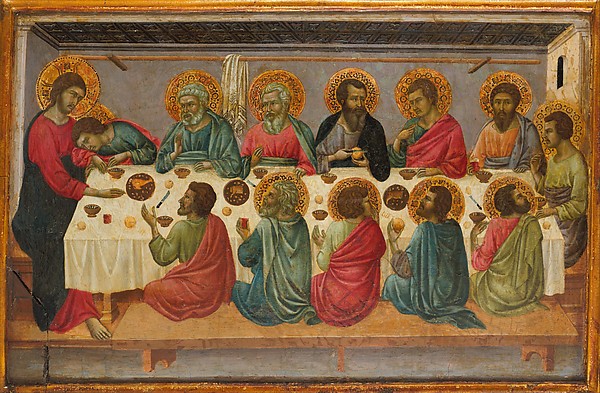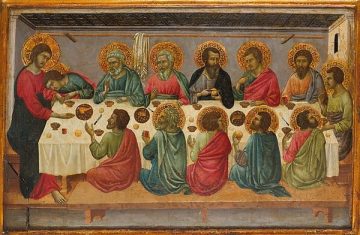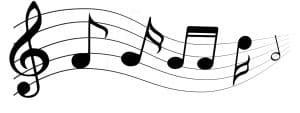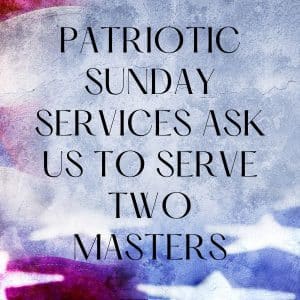
Instructions for the Teacher
This lesson from the HWH manual on the Sacrament deals with several different, but significant and symbolically linked concepts: the original Passover of the Children of Israel while in captivity in Egypt, the Passover as commemorated by Jews of ancient and modern times (including Jesus and his disciples), the institution of the Sacrament by Jesus to his disciples, the Resurrection, and the ordinance of the Sacrament as we know it today.
Preparations for the lesson
Divide the chalkboard in three sections with the following headings: The first Passover – Moses and the Children of Israel; Passover traditions in the days of Christ; The Sacrament today. Display Sacrament trays with only one small piece of bread and one cup. Optional: make or bring some matzah bread to share as an edible object lesson. (Recipe here.) Matzah bread is symbolic in the Jewish faith, and at their Passover dinner, as it represents the haste in which the children of Israel fled Egypt, without time for their bread to rise. When they were finally delivered, they had to act quickly!
I. The first Passover — Moses and the Children of Israel
In your own words, or from the scriptures (Exodus 3-12), or from the manual, or by inviting group discussion, teach the story of the plagues of Egypt and the eventual deliverance of the Children of Israel in leaving their captivity. Write discussion points on the chalkboard as they come up. Suggestions: some plagues experienced by only the Egyptians, the great and dramatic lengths the Lord went through to save his people, deliverance was delayed, but then came quickly and everyone had to move right away.
Discuss the final plague, the sacrifice of the lamb, the blood of the lamb across the door frames, the angels “passing over” the door, thereby sparing the life of the child inside. Discuss how the commemoration of the Passover began as the children of Israel camped in Gilgal.
Discuss the symbolism of the blood of the lamb being what saved the children.
Questions to ask: “In what other ways does the blood of the lamb symbolize the saving of God’s children?” “When it seemed like your deliverance would never come, and plague after plague kept arriving, what lengths did the Lord go through to save you?”
II. Passover traditions in the days of Christ
In your own words, or from the scriptures, or from the manual, or by inviting group discussion, teach how Passover was commemorated by Jesus Christ, including the unleavened bread, the herbs, and the paschal lamb. Discuss the transition Jesus made in using bread and wine to represent his sacrifice rather than an actual lamb. Since he was about to become the lamb, killed to save all of God’s children, no other lambs would be required. Include teachings from the manual about fulfilling the higher law, and the gift of eternal life through the Resurrection.
Share this quote:
On a visit to the Holy Land once, I stepped into the tomb thought to be the place where Jesus Christ was laid after His Crucifixion. As I stepped into the tomb, it occurred to me that it was not important if this was the exact place where His Resurrection transpired. What was important was that Jesus Christ had risen. He had conquered death. And because He was “the firstfruits of them that slept,” all mankind would “be made alive” (1 Corinthians 15:20, 22). Vicki F. Matsumori, Primary Presidency “Believe.” Ensign, July 2007
Share this quote:
As I have met with many women this last year—and their priesthood leaders—I have heard numerous accounts of Christ’s healing power. There is so much suffering in mortality, so many causes for pain. I know people who have sent loved ones into harm’s way and who daily pray for their safety in battle. I talk to parents who are frightened for their children, aware of the temptations they face. I have dear friends who are suffering from the ravaging effects of chemotherapy. I know single parents, abandoned by spouses, who are rearing children alone. I have dealt myself with the debilitating effects of depression. But I have learned from my own experience, and I learn from those I meet, that we are never left to our own resources. We are never abandoned. A wellspring of goodness, of strength and confidence is within us, and when we listen with a feeling of trust, we are raised up. We are healed. We not only survive, but we love life. We laugh; we enjoy; we go forward with faith.
Kathleen H. Hughes, Relief Society Presidency “Blessed by Living Water.” Ensign, May 2003
Questions to ask: “Would anyone like to share an experience of how you found hope or peace because of the Resurrection?” “In addition to the symbols mentioned in the Sacrament prayers, what else can draw our minds to the Resurrection during the Sacrament ordinance?”
III. The Sacrament Today
Invite discussion among the class participants to share ways they feel sanctified, forgiven, or purified during the Sacrament. Invite them to share strategies for keeping their minds focused on the Savior during this time. You may include the following quotes/experiences:
“When Diane was a new convert, she attended a branch outside of Johannesburg. One Sunday, as she sat in the congregation, the layout of the chapel made it so that the deacon did not see her as the sacrament was passed. Diane was disappointed but said nothing. Another member noted the omission and mentioned it to the branch president after the meeting. As Sunday School began, Diane was invited to an empty classroom.
“A priesthood holder came in. He knelt down, blessed some bread, and handed her a piece. She ate it. He knelt down again and blessed some water and handed her a small cup. She drank it. Thereafter, Diane had two thoughts in rapid succession: First, ‘Oh, he [the priesthood holder] did this just for me.’ And then, ‘Oh, He [the Savior] did this just for me.’ Diane felt Heavenly Father’s love.
“Her realization that the Savior’s sacrifice was just for her helped her feel close to Him and fueled an overwhelming desire to keep that feeling in her heart, not just on Sunday but every day. She realized that although she sat in a congregation to partake of the sacrament, the covenants she made anew each Sunday were individually hers. The sacrament helped—and continues to help—Diane feel the power of godly love, recognize the Lord’s hand in her life, and draw closer to the Savior.” Dale G. Renlund, Quorum of the Twelve Apostles “That I Might Draw All Men unto Me,” April 2016 General Conference
“When we open ourselves to the Spirit, we learn God’s way and feel His will. During the sacrament, which I call the heart of the Sabbath, I have found that after I pray for forgiveness of sins, it is instructive for me to ask Heavenly Father, ‘Father, is there more?’ When we are yielded and still, our minds can be directed to something more we may need to change—something that is limiting our capacity to receive spiritual guidance or even healing and help.” Neill F. Marriott, Second Counselor, Young Women General Presidency “Yielding Our Hearts to God,” October 2015 General Conference
Share the matzah bread as you round out the discussion about symbols of Christ, his sacrifice, his love for us, and his ability to save each of us. If you choose to share the story from the life of HWH about wanting to be baptized and ordained but his father wouldn’t allow it, invite discussion about how we can be inclusive and supportive of those within our congregations who might wish to be baptized or ordained but must wait (children whose parents do not allow these ordinances, children of gay couples who may not receive these ordinances until age 18, or other circumstances.)






6 Responses
This is wonderful. Any chance there will be a post for lesson 13?
It was posted late but here it is: https://exponentii.org/relief-society-hwh-chapter-13-the-temple-the-great-symbol-of-our-membership/
Thank you! I caught it
What was the purpose of dividing the chalkboard into 3 sections? You never seem to mention anything about what you are writing on the chalkboard.
Sorry to be unclear. I only describe it in one sentence, “Write discussion points on the chalkboard as they come up.”
For the visual learners in the group, it can help to see the discussion points organized visually as a way to keep track of the comparisons and contrasts between concepts.
How can I print this lesson?